

Nintendo is the long-time champion of the home video game market. From their first consoles to their latest motion-controlled "WII" system, they have always been on top with some of the best systems and games to appear.
Click any photo to view a large high-resolution image.
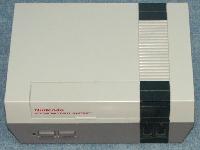 The NES is Nintendo's first system released in North America. It featured two
hand-held controllers and a light-gun which operates
by detecting a spot of light briefly flashed on the television screen. Nintendo
set the standard with their high quality games which were stored on
removable cartridges. By far the most popular system
of it's day, the NES is often faulted for the complicated and unreliable system
of loading cartridges through a door in the front
of the unit, into a spring loaded carrier which was then pressed down to make
contact.
The NES is Nintendo's first system released in North America. It featured two
hand-held controllers and a light-gun which operates
by detecting a spot of light briefly flashed on the television screen. Nintendo
set the standard with their high quality games which were stored on
removable cartridges. By far the most popular system
of it's day, the NES is often faulted for the complicated and unreliable system
of loading cartridges through a door in the front
of the unit, into a spring loaded carrier which was then pressed down to make
contact.
Views: Bottom, Back and Side connections, Arcade Stick, Robot/Deluxe Set".
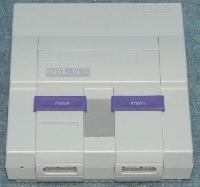 The Super Nintendo is Nintendo's 16-bit system. Better graphics, faster action
and some 3-D capabilities were a big improvement over the NES and the system
also proved extreamly popular.
The Super Nintendo is Nintendo's 16-bit system. Better graphics, faster action
and some 3-D capabilities were a big improvement over the NES and the system
also proved extreamly popular.
Views: Game Cartridges, Bottom, Back.
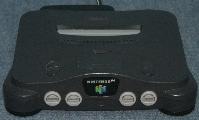 I regard the N64 as one of the best video game
consoles of all-time. Impressive graphics, quick loading (thanks to it's
continued use of cartridges, a new ergonomic and powerful
controller and truly great games! When
"SuperMario64" debuted, people were mesmerized by the smooth-flowing movie-like
graphics. We've come to expect this now, but in 1997 this was a truly
revolutionary console.
I regard the N64 as one of the best video game
consoles of all-time. Impressive graphics, quick loading (thanks to it's
continued use of cartridges, a new ergonomic and powerful
controller and truly great games! When
"SuperMario64" debuted, people were mesmerized by the smooth-flowing movie-like
graphics. We've come to expect this now, but in 1997 this was a truly
revolutionary console.
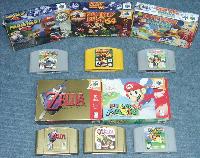 These are some of the best of the N64 games. Nintendo has always has an eye
to "good clean family fun". Incredible cartoon like graphics and animation,
good storylines and exciting movements are hallmarks of these Nintendo "classics".
These are some of the best of the N64 games. Nintendo has always has an eye
to "good clean family fun". Incredible cartoon like graphics and animation,
good storylines and exciting movements are hallmarks of these Nintendo "classics".
The games can be further enhanced by controller pak accessories which plug into the hand-held controller providing features such as additional memory storage, "rumble" (the controller shakes when you hit something - or something hits you!), and a transfer-pak to move data between the N64 and GameBoy systems. If you so inclined, third-party accessories like this GameShark could be used to "hack" the games to alter the play (a practice Nintendo never approved of).
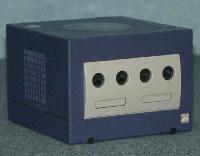 Named for it's boxlike shape, the GameCube is a
leap to a 64-bit power-PC architecture, and is capable of very impressive
performance. This is also Nintendo's first foray into optical storage, using
proprietary 8cm media which is very similar to the mini-DVD format. The proprietary
format was chosen as a means of copy protection.
Named for it's boxlike shape, the GameCube is a
leap to a 64-bit power-PC architecture, and is capable of very impressive
performance. This is also Nintendo's first foray into optical storage, using
proprietary 8cm media which is very similar to the mini-DVD format. The proprietary
format was chosen as a means of copy protection.
The silver cube on the right (see large-format photo) has a "GameBoy Player" attached - this expansion allows playing of GameBoy games on the cube. A network adapter which fits into the bottom of the unit is also available.
Views: Box, Controllers, Naked.
 Looking at the bottom and back, we can see three generations of GameCube. The
earliest unit on the left has a color matching backplate, both analog and
digital AV connectors on the back, and a full compliment of expansion ports.
The middle unit has "lost" one of the serial ports, although the plastics still
have a "hole" for it. The most recent Cube on the right has new plastics, a
generic black backplate (for all color cubes) and no longer has the digital
AV outputs.
Looking at the bottom and back, we can see three generations of GameCube. The
earliest unit on the left has a color matching backplate, both analog and
digital AV connectors on the back, and a full compliment of expansion ports.
The middle unit has "lost" one of the serial ports, although the plastics still
have a "hole" for it. The most recent Cube on the right has new plastics, a
generic black backplate (for all color cubes) and no longer has the digital
AV outputs.
Many early Cubes have had failures of the Optical pickup. Replacements are available from several sources (I've had to replace two so far).
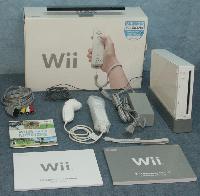 With the Wii, Nintendo took a new path for it's next generation console.
Instead of pumping the system with heat-blasting processing power and high
resolution graphics engines, they concentrated on the human interface, and
created a new and very well received way to interface with the system.
With the Wii, Nintendo took a new path for it's next generation console.
Instead of pumping the system with heat-blasting processing power and high
resolution graphics engines, they concentrated on the human interface, and
created a new and very well received way to interface with the system.
The "Wiimote" is like a wand that you move around, point and shake instead of "thumbs on a joystick". The emphasis on physical movement, as well as it's continued use of Nintendo's lovable characters and only mild cartoon-like violence has made the Wii the console of choice for families with younger children.
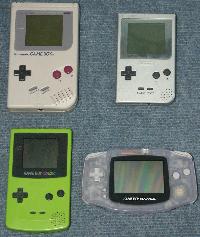 A line of portable gaming systems. Clockwise from upper left:
A line of portable gaming systems. Clockwise from upper left:
Original Monochrome Game Boy system
Updated/smaller Game Boy Pocket
Game Boy Color - first color screen
Game Boy Advance - New format, wider screen and more powerful processor.
Views: Back, Cartridges.
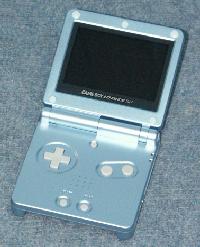 The Game Boy Advance SP is the last of the full size Game Boy series. This unit
folds into a compact block, and features the first
backlit screen in the Game Boy line. It also sports a rechargable battery.
The Game Boy Advance SP is the last of the full size Game Boy series. This unit
folds into a compact block, and features the first
backlit screen in the Game Boy line. It also sports a rechargable battery.
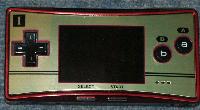 The Game Boy Micro is the last and smallest Game Boy. Smaller than the original
NES controller, the Micro gives up the ability to play Game Boy and Game Boy
Color games in favor of small size (It plays GBA games only). This particular
unit is a "Famicon Limited Edition" released on the 20 years aniversary of
Nintendo's first system, the "Famicon". The red and gold color represents the
coloring of the Famicon controller.
The Game Boy Micro is the last and smallest Game Boy. Smaller than the original
NES controller, the Micro gives up the ability to play Game Boy and Game Boy
Color games in favor of small size (It plays GBA games only). This particular
unit is a "Famicon Limited Edition" released on the 20 years aniversary of
Nintendo's first system, the "Famicon". The red and gold color represents the
coloring of the Famicon controller.
Views: Back.
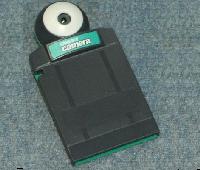 The Game Boy supports several accessories, including a printer, TV adapter,
wireless adapter, multi-player adapter, Mp3 player, link cables, and this
low resolution black and white digital camera adapter.
The Game Boy supports several accessories, including a printer, TV adapter,
wireless adapter, multi-player adapter, Mp3 player, link cables, and this
low resolution black and white digital camera adapter.
Views: Larger and back
 The Nintendo DS (Dual Screen), is the latest (as of 2007) offering from
Nintendo in the portable gaming arena. It features TWO complete screens,
with the lower one also serving as a touch pad (stylus included). It also
features built-in WiFi connectivity for shared gaming and network play.
Like the GBA-SP, it folds for storage and transport.
The "Lite" model is a second generation - smaller and lighter with brighter
screen.
The Nintendo DS (Dual Screen), is the latest (as of 2007) offering from
Nintendo in the portable gaming arena. It features TWO complete screens,
with the lower one also serving as a touch pad (stylus included). It also
features built-in WiFi connectivity for shared gaming and network play.
Like the GBA-SP, it folds for storage and transport.
The "Lite" model is a second generation - smaller and lighter with brighter
screen.